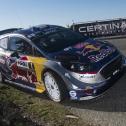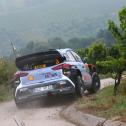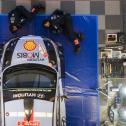Pressekontakt
ADAC e.V.
Oliver Runschke
Motorsport- und Klassik-Kommunikation
Tel.: +49 89 7676 6965
Mobil: +49 171 555 6236
E-Mail: oliver.runschke@adac.de
Kay-Oliver Langendorff
Leiter Partnerschaften, Kooperationen & Sponsoring
Leiter Kommunikation Motorsport & Klassik
Tel.: +49 (0)89-7676 6936
Mobil: +49 (0)171-555 5936
E-Mail: kay.langendorff@adac.de
01.06.2017 - ADAC Rallye Deutschland
The ADAC Rallye Deutschland is an extreme challenge both for the drivers and the cars
- The German WRC rally is extremely tough on the WRC cars
- The variety of the itinerary mix presents major challenges to the material
- In-situ testing units are a requirement for the teams
Munich. The ADAC Rallye Deutschland (17 to 20 August 2017) has always been one of the moist challenging rallies on the FIA World Rally Championship schedule. This is al the more true this year since a series of new tests is waiting for the world rally driver elite in Germany in 2017. Star rally drivers such as Sébastien Ogier or Thierry Neuville are running an intensive testing programme in preparation for the ADAC Rallye Deutschland. To stay ahead of the game in the challenging German asphalt rally, the major works teams such as Hyundai Motor Sport or the M-SPORT WORLD RALLY TEAM implement numerous technical adaptations to their rally cars.
Challenge #1: surfaces
Apart from a variety of surfaces, asphalt does not equal asphalt in the ADAC Rallye Deutsch-land. On the Baumholder military range, where the infamous Panzerplatte Special Stages are scheduled on Saturday, 19 August, a variety of surfaces challenges the teams, from pure concrete to concrete interspersed with rocks, to rough asphalt to sections of cobblestone pavement. Here, the right selection of tyres can be decisive since the surfaces are very tough on the tyres. On top of all this comes the weather to make a real conundrum for the WRC team strategists. As experience has shown, weather conditions are quick to change in the Saarland, Palatinate and Eifel regions hosting the rally.Challenge #2: the specific rally German WRC car setup
To cope with the ADAC Rallye Deutschland's variety of surface profiles, the teams usually opt for a very precisely balanced setup answering to a variety of technical requirements. The one underlying commonality of WRC car setups for the rally Germany is that, unlike for the WRC gravel rallies, chassis setup is considerably lower. The suspension setup is stiffer and suspension travel is shorter. To cut weight, lighter components are being used in terms of shock absorbers, transverse links and tie rods. Since asphalt is generally smoother than gravel, the top teams also dismantle some of the underbody protection to save additional weight.Challenge #3: the choice of brakes
The numerous 90-degree turn-offs, hairpin turns, up and downhill passages of the ADAC Rallye Deutschland are extremely tough on the brakes of the WRC cars. What is more, the distances to cover in some Special Stages are long, such as the close to 42 kilometres of the Panzerplatte marathon. To live up to such challenges in Germany, the teams use the largest brakes in the whole WRC circuit. The brakes must be both aggressive and provide very robust performance. Not to mention the fact that the rim sizes used for the German asphalt rally are also larger than those used in the WRC gravel rallies.Top teams go back to testing before the ADAC Rallye Deutschland
After five consecutive gravel rallies (rallies Argentina, Portugal, Italy, Poland and Finland), at the ADAC Rallye Deutschland, the WRC is back on asphalt. To ensure optimum preparedness for this change, multi-day test sessions just before the rally are a virtual must for the works teams. The tests are used to find the optimum differential and damper setup and to reacquaint the drivers with the specific rigors of asphalt driving. The tests also allow the teams to have a look at the many new challenges the organisers of the ever-evolving ADAC Rallye Deutschland hold in store for them every year.Gravel Crews decisive in Germany
More important than even in other WRC rallies, is the input of the so-called Gravel Crews. These team spies drive the Special Stages shortly before the start to brief the drivers on the latest road conditions. This information may be decisive in the tight vineyard Special Stages where the drivers cut corners. These shortcuts leave a lot of gravel and dirt on the roads which may change the grip level from one instant to the next. Thanks to the quick briefs from the Gravel Crews, the top drivers can adjust their driving accordingly.Get your rally and day passes in pre-sale now!
In addition to the four-day rally passes, the fans can now also buy day passes for Friday, Saturday or Sunday in pre-sale. On the day printed on the pass, passholders get access to all spectator areas along each Special Stage and the ADAC Rallye Deutschland Service Park. In 2017, fans can also buy self-print passes. They serve as proof of purchase to be redeemed for rally passes or day passes at the rally venue. Visit the official ticket shop on the web at www.adac.de/rallye-deutschland (go to the Tickets tab).Pre-sale buyers will enjoy discounts and attractive packages, including the official ADAC Rallye Deutschland event guide. The same as last year, the pre-sale price of a rally pass package is EUR70 (EUR65 for ADAC members). Day passes are available for EUR35 exclusively in pre-sale.
The rally passes cover:
- Access to all Special Stages on all days
- Access to the Service Park on all days
- Access to the Shakedown on Thursday
- A spectator map providing all the essential information about the rally
- ADAC Rallye Deutschland lanyard
- ADAC Rallye Deutschland sticker
- The ADAC Rallye Deutschland magazine (in German with essential information in English and French)



